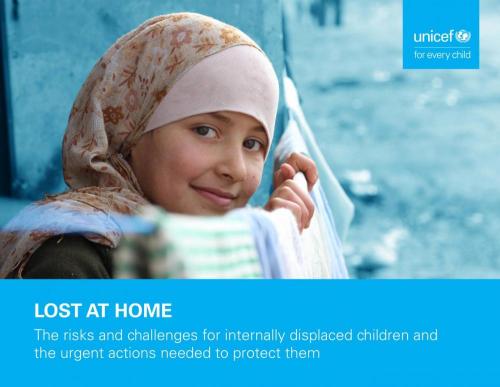
https://www.unicef.org/press-releases/19-million-children-internally-dis...
The report, ‘Lost at Home’, looks at the risks and challenges internally displaced children face, and the urgent actions needed to protect them. As COVID-19 continues to spread around the world, these children are among the most vulnerable to its direct and indirect impacts.
“Millions of displaced children around the world are already going without proper care and protection,” said UNICEF Executive Director Henrietta Fore. “When new crises emerge, like the COVID-19 pandemic, these children are especially vulnerable. It is essential that governments and humanitarian partners work together to keep them safe, healthy, learning and protected.”
Internally displaced children lack access to basic services and are at risk of exposure to violence, exploitation, abuse and trafficking, the report says. They are also at risk of child labour, child marriage and family separation which all pose direct threats to their health and safety.
The COVID-19 pandemic is making a critical situation for displaced children and families even worse. They often live in overcrowded camps or informal settlements, where access to basic hygiene and health services is limited, and where physical distancing is not possible. These conditions are highly conducive to the spread of diseases like COVID-19.
According to the report, there were 12 million new displacements of children in 2019, 3.8 million of them were caused by conflict and violence, and 8.2 million by disasters linked mostly to weather-related events like flooding and storms.
Through the report, UNICEF calls for strategic investments and a united effort from governments, civil society, private sector, humanitarian actors and children themselves to address the child-specific drivers of displacement, especially all forms of violence, exploitation and abuse.
UNICEF also calls on governments convening under the High-Level Panel on Internal Displacement, established by United Nations Secretary-General António Guterres, to take concrete action and investment that will help provide protection and equitable access to services for all internally displaced children and their families.
Critical to delivering on this agenda is better, timely and accessible data and evidence, disaggregated by age and gender, to improve collective understanding of how internal displacement affects children and their families. Internally displaced children and youth themselves must have a seat at the table, be taken seriously and offered the opportunity to be part of the solution, the report says.
https://data.unicef.org/resources/lost-at-home-risks-faced-by-internally...
Today, more children than ever before are displaced within their own countries. At the end of 2019, an estimated 46 million people were internally displaced by conflict and violence. More than 4 in 10 – or 19 million – were children. Millions more were displaced by disasters. Forced out of their homes and communities, these children are among the most vulnerable in the world. The ongoing COVID-19 pandemic stands to bring even more harm and uncertainty to their lives.
The report below provides the latest data, which demonstrate the scale and scope of internal displacement around the world. It also reveals how internal displacement upends the lives of children, affecting all spheres of their lives:
- It often breaks families apart and forces children to move on their own or live with limited support from families and communities.
- It multiplies protection and safety risks. Internally displaced children are particularly vulnerable to abuse, violence and exploitation as social norms break down and protective services are no longer available.
- It often disrupts education by delaying or entirely interrupting children’s learning, depriving them of the opportunity to reach their full potential.
- It poses challenges to accessing essential services such as safe housing, water and sanitation, and health care or psychological support.
The sum of these deprivations can be particularly acute in the life of a child and cause long-lasting harm.
For millions living in internal displacement, crowded living quarters, limited to no access to clean water and sanitation, and severely curtailed health care are common. Those in hard-to-reach places may also be cut off from mass communications, meaning they are likely to miss out on lifesaving public health messages. These factors set the course for rapid spread of COVID-19. Urgent efforts are needed to address the poor living, WASH, and health care conditions of internally displaced persons to prevent further damage to these already fragile communities and their vulnerable children.










Add new comment